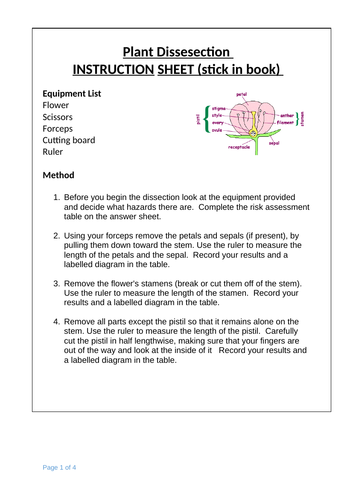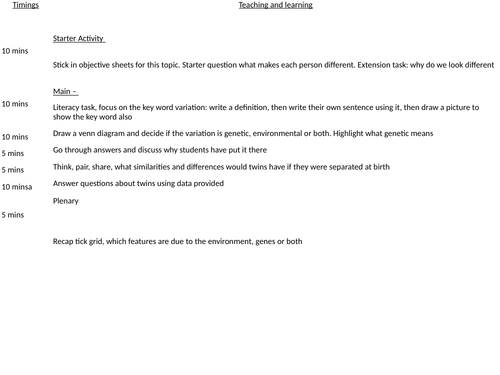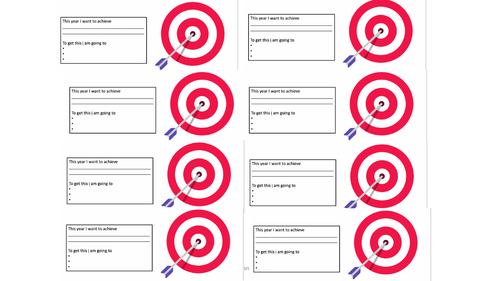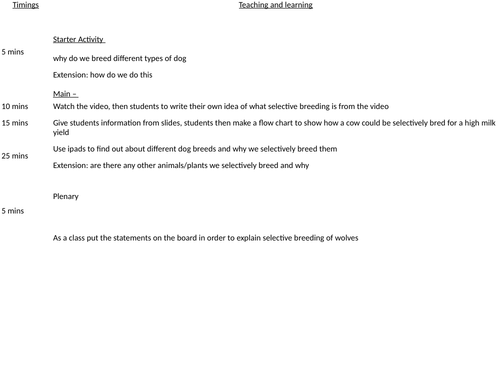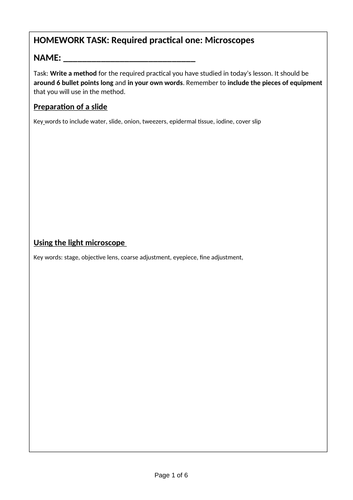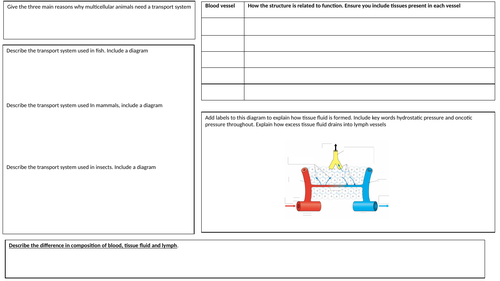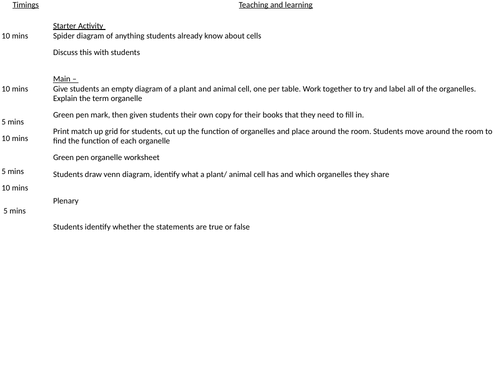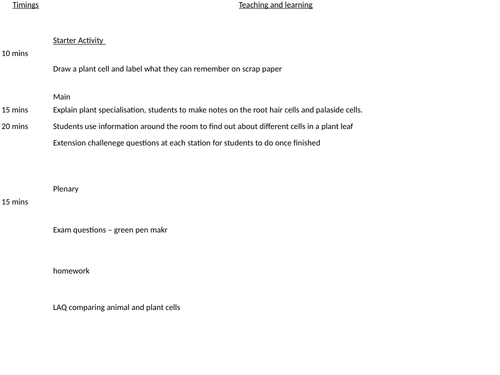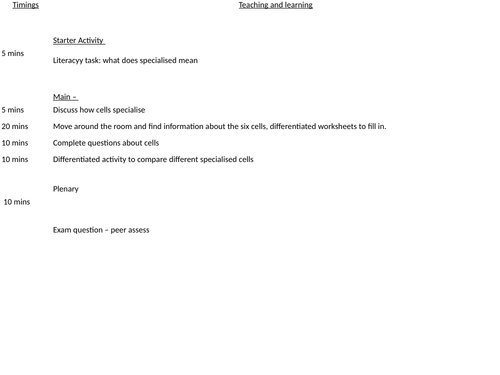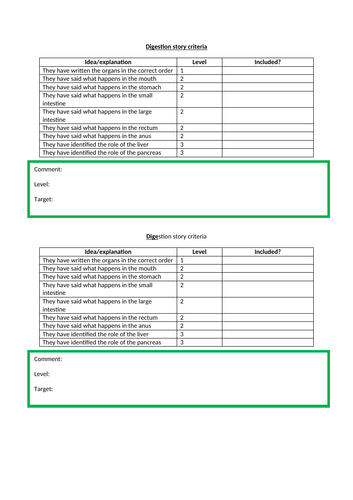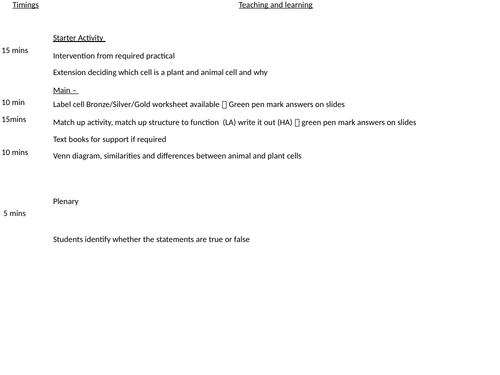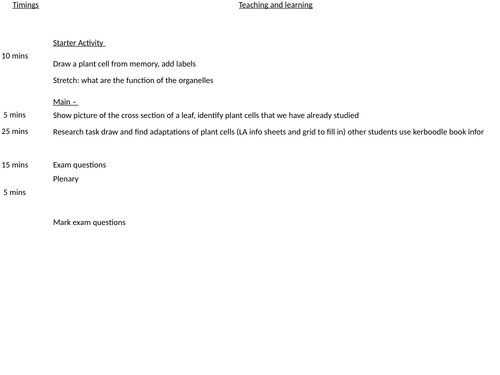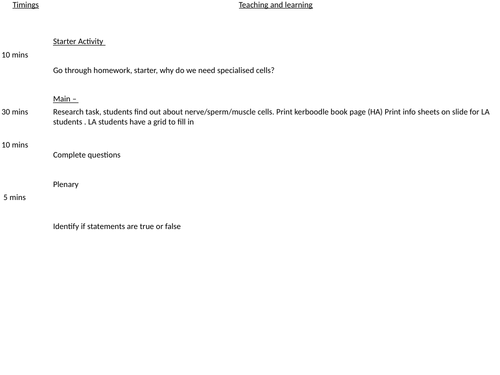
123Uploads
27k+Views
8k+Downloads
Biology

Structure of a plant
Aimed at KS3 students.
This lesson recaps KS2 prior knowledge on the structure of a plant. Before moving onto KS3 content about structure and function of parts of the plant, followed by a plant dissection, accompanied by worksheets.

B13.1 variation and evolution
Aimed at a low ability class.
Starter Activity
Stick in objective sheets for this topic. Starter question what makes each person different. Extension task: why do we look different
Main –
Literacy task, focus on the key word variation: write a definition, then write their own sentence using it, then draw a picture to show the key word also
Draw a venn diagram and decide if the variation is genetic, environmental or both. Highlight what genetic means
Go through answers and discuss why students have put it there
Think, pair, share, what similarities and differences would twins have if they were separated at birth
Answer questions about twins using data provided
Plenary
Recap tick grid, which features are due to the environment, genes or both

B13.2 Evolution by natural selection
Aimed at a low ability class
Starter Activity
Pictures of animals with the albinism mutation, students decide if they think this is beneficial or not and explain their answer
Main –
Think pair share for one minute to discuss the word mutation. Then do a vocab lab for the definition
Fill in the blanks about mutations, print for LA students
Watch video about Charles darwins natural selection. Then cut and stick the statements into order to describe natural selection. Green pen mark
Explain how the lion is adapted and how these adaptations are beneficial.
Complete exam questions. Extension question available on powerpoint.
Plenary
Mark exam question

B13.3 selective breeding
Aimed at a low ability class
Starter Activity
why do we breed different types of dog
Extension: how do we do this
Main –
Watch the video, then students to write their own idea of what selective breeding is from the video
Give students information from slides, students then make a flow chart to show how a cow could be selectively bred for a high milk yield
Use ipads to find out about different dog breeds and why we selectively breed them
Extension: are there any other animals/plants we selectively breed and why
Plenary
As a class put the statements on the board in order to explain selective breeding of wolves

B16.1 feeding relationships
Aimed at low ability KS4 students, targets of level 3/4
Starter: Differentiated synoptic questions linking to B8 photosynthesis.
Main: match up key words, then link key words to food chain.
differentiated 6 mark question.
Broken down 6 mark question to build confidence, focusing on key words. Bronze/silver supportive sheets Gold students just answer the question.
Plenary: Mark scheme on powerpoint for students to mark and improve their answer.

Biology paper 1 revision
complete paper one revision.
Aimed at low ability foundation students.
Inspired by Dr Edmunds
Booklets include fact sheets for each topic, each fact sheet has page numbers from the CGP foundation revision guide for support.
There are answers for these fact sheets for students to check their answers.
Each topic also has a page of exam questions for students to practice their knowledge. answers for these are in the back of the booklets
Hopefully will be of help.
Any feedback welcome :)

B1.1 The blood
Aimed at a mixed ability year 9 class
Starter Activity
C2 retrieval practice questions – go through the answers.
Stick in objective sheets for this topic
Main –
Think pair share – what is the blood made up of? Go through answers, show students a photomicrograph of the different cells
Students then use the handout to make a grid of the function of the different parts of the blood.
Extension questions at the bottom to challenge level 4+ students
Go through answers, ensure everybody knows key function for each type of cells
Six mark question – students have ten minutes to answer questions. Then green pen mark
Watch a video of a blood donation, have a mini debate – would you give blood?
Plenary
Plenary key questions to answer

Photosynthesis and use of glucose
Starter Activity
No goal retrieval starter. Students given a picture of the structure of the leaf and annotate what they can remember.
Go through answers, students annotate anything they did not already know.
Main –
Students listen whilst teacher explains what photosynthesis is (5minutes)
Students answer task 1 and task 2 – write the equation and describe the process of photosynthesis (10 minutes) Success criteria can be given to LA students for support
Go through answers, success criteria on the board, question students for answers, green pen answers (5 minutes)
Students think of the answer to the questions on the board whilst demonstrate the testing for starch test.
Students move around the room to find ways plants use glucose
Plenary
Differentiated exam questions

B1.1 The world of the microscope
Starter Activity
Starter questions about the microscope
Main –
Students stick microscopes in the middle of their page. Use the information on the slide to label the parts of the microscope. Extension: to explain how to use a microscope
Check answers – answers on the PowerPoint. Students check answers, ensure students know the function of each part of the microscope.
Explain magnification and resolution, get students to write the definitions.
Think pair share, pictures of light and electron microscopes, see what students can summarise as differences
Students to make a grid in their books light vs electron microscopes, make notes on any differences from the video
Sort the statements and go through answers
Explain how to work out total magnification and then practice.
Explain the magnification equation and then practice using it
Plenary
Fill in the gaps in the sentences

Microscopes required practical
Three differentiated resources. Cant be used as homewowrk or for required practical revision. Good to use as a retreival resource after the practical.
Each differentiated resource has a space to write the required practical method, low level sheets have key words to guide them. Each resource has different exam questions dependent on level.
All answers included.
I print 2 sheets per side, back to back. Be careful if you shrink to A5 some of the answers for the magnfication questions will change as the image size measured will be different.

Plant and animal cells KS3
Aimed at a mixed ability year 7 class
10 mins
Spider diagram of anything students already know about cells
Discuss this with students
Give students an empty diagram of a plant and animal cell, one per table. Work together to try and label all of the organelles. Explain the term organelle
Green pen mark, then given students their own copy for their books that they need to fill in.
Print match up grid for students, cut up the function of organelles and place around the room. Students move around the room to find the function of each organelle
Green pen organelle worksheet
Students draw venn diagram, identify what a plant/ animal cell has and which organelles they share
Plenary
5 mins
Students identify whether the statements are true or false

Plant cells, tissues and organs KS3
Aimed at mixed ability year 7 class - some resources from other areas of TES
Starter: memory task, draw and label a plant cell with all they can remember
Main: draw and label root hair cell and palasaide cell, write the function and adaptations
use information around the room to fill in diagram of cells in a leaf and how they help photosynthesis
extension questions at each station
Plenary: exam questions

Animal cell specialisation KS3
Aimed at a mixed ability year 7 class
Starter: What does specialised mean?
Main: research task move around the room to find out about specialised animal cells
differentiated worksheet
answer questions about the cells
differentiated task to compare different cells
Plenary: Exam questions

Microscopes practical KS3
Aimed at mixed ability year 7 class
Starter: work out magnification
Main: Complete practical looking at onion epidermis and cheek cells
practical sheet to fill in
Plenary: Peer assess their practical work

The digestive system KS3
Aimed at mixed ability year 7 class
Starter: label the digestive system, green pen mark
Main: Move around the room and find information about the key organs of the digestive system
HA/MA/LA sheets to fill in
Write a food story of food moving through the digestive system
Plenary: peer assess food story, marking sticker included

B1.2 Animal and plant cells
Aimed at a mixed ability year 9 class
Starter: identify which cell is a plant cell and which is an animal cell and explain why
Main: Label plant and animal cells differentiated worksheets (bronze silver gold)
Match up strucutre and function of organelles
venn diagram similarities and differences between plant and animal cells
Plenary: true/false questions

B1.5 specialisation in plant cells
Aimed at a mixed ability year 9 class
Starter: recap draw and label plant cell. Stretch, describe the role of each organelle
Main: Discuss where the palaside cells are found, discuss why they are adapted for their function being here
research task: HA/LA versions find out about root hair cells, xylem, phloem
Exam questions
Plenary: mark exam questions

B1.4 Specialised animal cells
Aimed at a mixed ability year 9 class
Starter: why do animals have specialised cells, try and identify cells in the pictures
Main: Research task - using kerboodle books or any other resource, research criteria to meet for each cell.
Lower ability information sheets, and grid to fill in for LA students
Extension: answer questions
Plenary: identify if statements are true/ false

